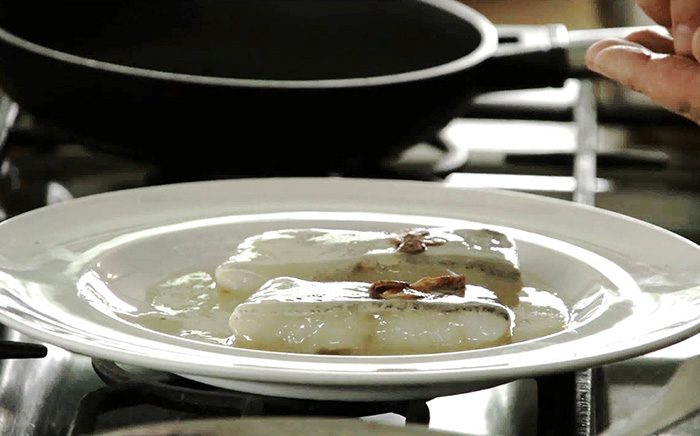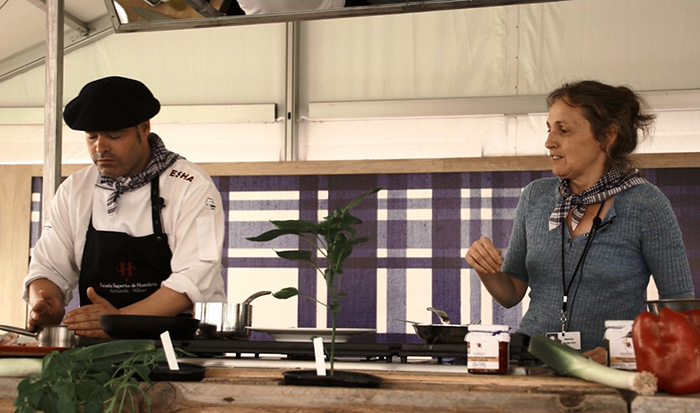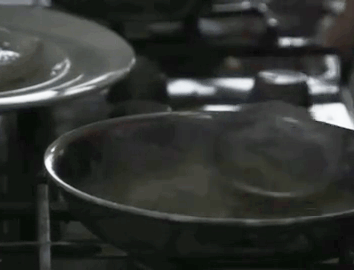Basque Recipe: Bakailaoa Pil-pilean

Bakailaoa pil-pilean is perhaps the Basque country’s best known dish. The recipe itself is simple, but the dish is not easy to make. In the txokoak, or Basque gastronomy clubs, cooks compete to see who can make the best bakailaoa pil-pilean. The dish is made using cod with the skin still attached. It can be difficult to find salt cod with skin in the United States, but it is worth the extra effort since the sauce can’t be made without the natural gelatin in the skin.
At the 2016 Folklife Festival, Basque chefs Igor Ozamiz Goiriena and Igor Cantabrana made sure that bakailaoa would be featured in the cooking demonstration tent, Ostatus Kitchen. To ensure they had enough fish, they packed eighteen pounds of dried cod in their suitcases on their way to Washington, D.C.
Whales, Cod, and Salt: A History of Basque Cod Fishing
Bakailaoa pil-pilean has a long history tied to Basque whaling and cod fishing. Cod is a traditional fish used in Basque gastronomy, brought from the North Sea and later from North America. The Basque people originally went to Greenland and Newfoundland to hunt whales as early as the late fifteenth century and began cod expeditions in the area not long after. In fact, the Basque were able to travel such distances partly because of large schools of Atlantic cod they would catch and salt to preserve. When whales became too scarce, Basque whalers switched primarily to fishing cod, which they would bring back to the Basque country to trade for salt and wine, among other goods.
The Basque were among the first people to salt cod, using salt from the natural springs in the Añana valley. This made the fish longer lasting and easier to trade. As early as the eleventh century, Basque salt cod was sold on an international market. Today the rehydrated salt cod used in bakailaoa pil-pilean, with its flaky texture, is considered by some to taste better than fresh cod[1].

Chef Igor O. explained that bakailaoa pil-pilean was his favorite dish to demonstrate at the Folklife Festival because of this rich history. He also has his a personal connection to the dish, as his grandfather was a captain of a cod ship that sailed to St. John’s, Newfoundland. His grandfather told him that there were once so many cod in the sea that you could walk on water. His traditional recipe for bakailaoa pil-pilean came from his grandmother.
Science in Cooking: Emulsified Sauce
Bakailaoa pil-pilean is a simple dish in theory but difficult to execute. The sauce, made from the gelatin of the cod and olive oil, is an emulsion—the combination of two liquids that are not normally soluble. To make pil-pil sauce, Igor O. explains that you need the right balance of four things: water, fat, air, and an emulsifying agent. With the perfect balance, you can create a creamy, yellow-white sauce.
Atlantic cod is a cold-water fish, meaning its gelatin is high in both fat and amino acids. As such, the gelatin easily provides the fat required to make pil-pil sauce while also serving doubly as an emulsifying agent. Gelatin works well as an emulsifier because it has elements that are both water soluble (mixes with water) and fat soluble (mixes with fats), allowing it to form a barrier between fat droplets and the liquid in which they are dispersed. The amino acids form a tangled net that traps fat droplets, further dispersing the fat and stabilizing the mixture. The olive oil brings in more fats and water.
With just gelatin, olive oil, and air, the fish has all four main requirements for an emulsion. However, emulsions do not form on their own, as they are rather unstable. You need to give energy and air to the emulsion by shaking and stirring the gelatin as you mix in olive oil. This turns the fat into droplets that can then be trapped by the gelatin.

Chef Gorka Mota explained that in one Basque legend, pil-pil sauce was first created by the rocking motion of fishing ships at sea. Another legend suggests that the dish has roots in the First Carlist War: a merchant’s request for salt cod was misinterpreted by the telegraph operator, and he ended up ordering a million salt cod. It was a fortunate error, as Bilbao was soon under siege, and the only food available was salt cod, olive oil, garlic, and dried pepper. To survive, the people of Bilbao ate cod cooked in olive oil. By the end of the century, Basques discovered that if the cod was cooked in an earthen casserole dish and moved in a circular motion, the sauce would become creamy and white[2].
In his own cooking, Igor O. uses a mesh colander to create pil-pil sauce, a technique he learned in culinary school. With the colander he mixes the gelatin while he slowly pours in olive oil. This technique is highly effective at adding air and causing it to emulsify. Using a colander is also very innovative—his grandmother, he joked, would be mad at him for doing so. She did not know, as chefs do today, that pil-pil sauce is an emulsion. However, she knew from experience and tradition that if she rotated the pot in circles, the pil-pil sauce would be creamy.
New techniques have been adopted by chefs as Basque cooking incorporates more knowledge from chemistry and other sciences. Today, a chef-in-training must learn more than just cooking: they also study science, nutrition, accounting, and much more. Basque chefs bring this new knowledge and innovatively apply it to traditional cuisine.

Recipe: Bakailaoa Pil-pilean (Cod in Pil-Pil Sauce)
Makes two servings
Ingredients
8 oz. (1 loin) salted and dried cod with the skin attached
1-2 cups extra virgin olive oil
3-4 garlic cloves
Instructions
- Soak the dried salt cod in cold water for 48 hours to rehydrate. Change the water every 8 hours. Once done, cut into 2 even chunks about 2 inches wide.
- In a 3-quart saucepan, add a layer of olive oil (~1/2 cup). Add 2 tablespoons of chopped garlic. Place the pot on low heat (~158 degrees Fahrenheit). Let the garlic perfume the oil for 2 to 3 minutes. Strain the oil to remove the garlic. Put the oil back in the pot.
Note: The olive oil should not change color. If it does, the heat is too high, and the garlic is frying.
- Add the slices of cod to the pot. Add more olive oil to cover the fish (~1 cup). Keeping the heat low (158-176 degrees), bring the oil to a boil. Let the fish poach slowly so that it releases its gelatin. The gelatin will come out as bubbles, separate from the oil, and settle at the bottom of the pot.
Note: Place the fish cuts close to one another to conserve oil. You will use a lot of oil but it is needed to poach the fish. Make sure to keep the heat low or the gelatin will evaporate.
- After poaching for around 20 minutes, remove the fish. It is done when the meat comes off in petals and has a white coloring.
- Stir the remaining oil and gelatin in small circles to further separate. Pour out the oil and keep it for later.

- Put the gelatin in a 10-inch sauté pan at room temperature. Stir the gelatin with the bottom of a mesh colander or tea strainer to solidify it. Using the colander, slowly add the oil back while continuing to stir the gelatin. Add oil until it becomes a thick sauce. It will be yellow-white and creamy.
- Place the fish in the pan with the finished pil-pil sauce. On low heat, reheat the cod and pil-pil sauce. Use a spoon to baste the fish in the sauce for 1 to 2 minutes. Remove the fish, and place it in a serving dish. Stir the sauce a few times, and then add it to the serving dish so that it lightly covers the fish.
- Optional: As a finish, add roasted garlic to the top of the fish.
Are you ready to try bakailaoa pil-pilean? Let us know how it goes in the comments below.
Shanna Killeen is a Basque program intern for the Smithsonian Folklife Festival. She recently graduated with degrees in English and Spanish, and she is currently working on a master’s in English at Oregon State University.
[1] Mark Kurlansky, Cod: A Biography of the Fish that Changed the World (New York: Penguin Books, 1997), 17-31.
[2] Mark Kurlansky, The Basque History of the World (London: Random House, 2000), 129-133.

